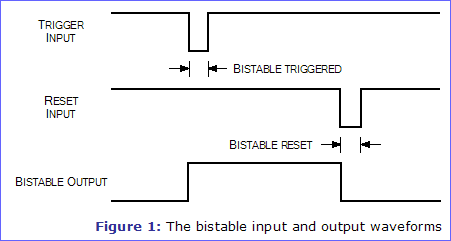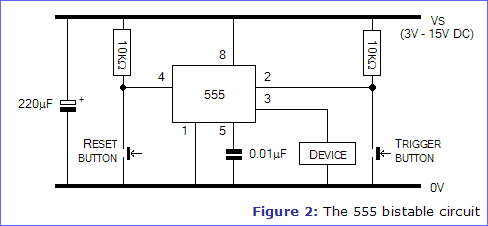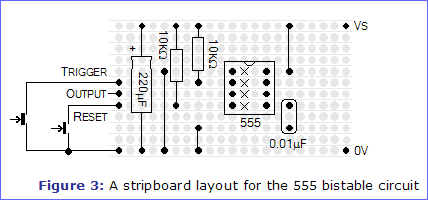The 555 Bistable Circuit
By Tim Surtell
In the final article in this series we will look at the simplest circuit you can build with the 555 IC - the bistable. As the "bi" in its name suggests, the bistable has two stable states, high and low.
The waveforms in figure 1 illustrate the operation of a bistable. Taking the Trigger input low makes the output of the circuit go into the high state. Taking the Reset input low makes the output of the circuit go into the low state.
This type of circuit is ideal for use in an automated model railway system where the train is required to run back and forth over the same piece of track. A push button (or reed switch with a magnet on the underside of the train) would be placed at each end of the track so that when one is hit by the train, it will either trigger or reset the bistable. The output of the 555 would control a DPDT relay which would be wired as a reversing switch to reverse the direction of current to the track, thereby reversing the direction of the train.
| Related Articles | The 555 Timer - Background information about the 555 | |||||
| The 555 Astable Circuit - Includes an introduction to waveform terminology | ||||||
| The 555 Monostable Circuit | ||||||
| Motor Reversing Switches - How to wire up a DPDT reversing switch |

Since there is no timing involved in this circuit, no equations are needed to work out the components. The circuit diagram is given in figure 2.

A stripboard layout for the 555 bistable circuit is given in figure 3. It provides a direct output from the 555 (pin 3), but if you want the bistable to control another device, such as a motor, you will probably want to leave some extra board space for any extra components required, such as a DPDT relay. Some suggestions are given in "Using the 555 output" from part 1 of this series, The 555 Timer.
The 220μF capacitor is included to smooth the power supply, and can be omitted if you are using a regulated supply or the circuit functions correctly without it.

Article Information
Source: Electronics in Meccano - www.eleinmec.com
| First published in EiM: Issue 5 (September 1999)
Topic: Digital Electronics |
Created: 29/05/2003 |
Last modified: 15/02/2007
Top of Page | Homepage | About | Search | Topics | Features | Circuits Shop | yourEiM |
© 1998 - 2024 Tim Surtell |